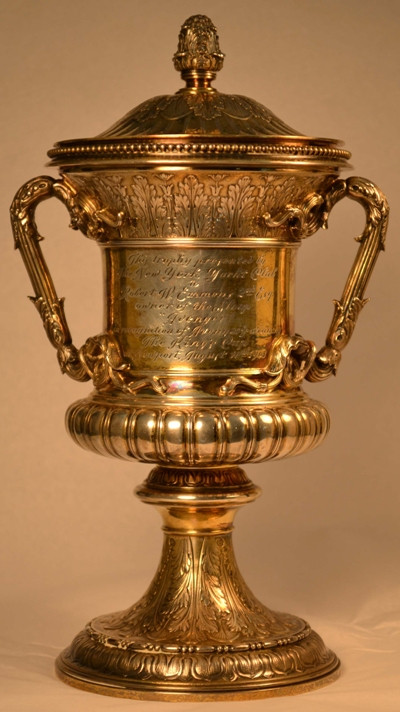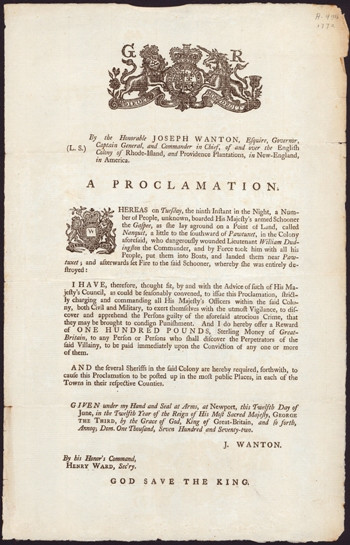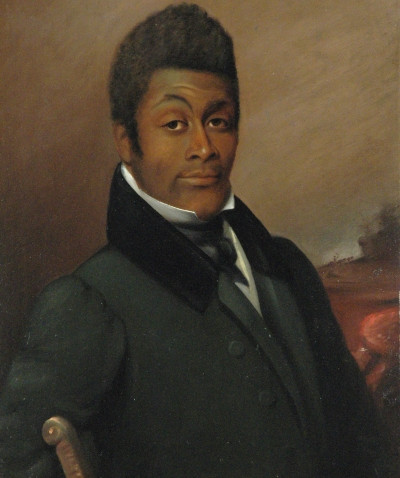slides: Newport Antiques Show: Objects that Shaped Rhode Island History
Sunday, July 20, 2014
GoLocalProv Lifestyle Team
 View Larger +
View Larger +
King’s Cup Trophy by Tiffany & Co., 1908
The
Rhode Island Historical Society and the
Newport Historical Society—sister organizations with a common origin in 1822— have partnered to create an exhibit that encompasses Little Rhody’s history with fifty distinct objects from their extensive collections. It will be presented at the 2014 Newport Antiques Show in the loan exhibit
Fifty Objects That Shaped Rhode Island History July 25, 2014-July 27, 2104 at St. George’s School in Middletown. The exhibit includes diverse themes such as geography and tolerance.
"Rhode Island, founded by an immigrant in 1636, has a rich, complicated history,” said Kirsten Hammerstrom, Director of Collections at the Rhode Island Historical Society. “Its coastline encouraged a robust maritime trade and the entrepreneurial spirit of its people made it a vanguard in the industrial revolution.”
“Rhode Island has served as a haven for the religiously persecuted and an incubator for innovators and rabble-rousers, who were sometimes one and the same. Not immune to the uglier parts of history, Rhode Island has seen its share of inequalities and injustices, as its inhabitants ride the tide of shifting demographics and changing economies,” Hammerstrom said.
GET THE LATEST BREAKING NEWS HERE -- SIGN UP FOR GOLOCAL FREE DAILY EBLAST
Since 2007, the Newport Antiques Show remains the only high-end antiques event with two beneficiaries, the Newport Historical Society and the Boys & Girls Clubs of Newport County, raising over $1.6 million through sponsorships and ticket sales.
“The partnership behind this year’s loan exhibit is a natural extension of the many collaborations that make the Show possible,” the Newport Historical Society’s Executive Director Ruth Taylor said.
During the Newport Antiques Show’s three day run, over forty-two of the country’s top dealers will present a diverse selection of Americana antiques ranging from furniture, paintings, jewelry and many other decorative arts at St. George’s School in Middletown, RI. Admission to the weekend Show, which costs $15 per person or $20 for a three day pass, allows entrance to Fifty Objects and the following talks.
· Big History, Little State: 350 Years in 50 Objects presented by Kirsten Hammerstrom on Friday, July 25th at 11am.
· Fruits of Our Labor: Industry, Immigration and Rhode Island Road to Riches by C. Morgan Grefe on Friday July 26th at 1pm.
· Vintage Cars and Automobile Racing in Newport on July 26th at 11am by Nicholas Schorsch, CEO of the Show’s Presenting Sponsor American Realty Capital.
“For a small state, Rhode Island has a powerful reach that can be seen in the material evidence of its past,” Hammerstrom said.
To see a preview of Fifty Objects That Shaped Rhode Island History, see the slides below.
Related Slideshow: Newport Antiques Show: Objects that Shaped Rhode Island History
 View Larger +
View Larger +
Prev
Next
King’s Cup Trophy by Tiffany & Co., 1908
Newport Historical Society, 83.3.1AB
In 1907, ‘Captain Nat’ (Nathanael Greene) Herreshoff designed the sloop Avenger for Robert Emmons 2nd of the New York Yacht Club; the Avenger was one of Herreshoff’s most successful boats, winning the Astor, Queen’s and King’s Cup races for her owner.
 View Larger +
View Larger +
Prev
Next
Seal, 1696, From the City of Newport “Seal of Newport Rhoade Island Covncel”
Newport Historical Society, L65.3.1
Before Newport was a thriving port and vacation destination, the city was a refuge for religious dissidents from Massachusetts Bay. The sheep depicted on this early seal attributed to Arnold Collins, reflects the importance of agriculture to the early settlers.
 View Larger +
View Larger +
Prev
Next
Weaver’s Book, 1815, Arkwright Company Records
Rhode Island Historical Society, MSS 264
The first mills in Rhode Island produced thread, not cloth. This was woven by hand, often on looms in homes or on farms. The swatches—typical of the patterns found in clothing and household linens throughout the 18th and early 19th centuries—are accompanied by instructions for weavers that represent the moment just before the industrialization of cloth production in New England.
 View Larger +
View Larger +
Prev
Next
Torpedo earrings and ID badge ca. 1945
Newport Historical Society, 97.23.2; 2003.15.2
Important Rhode Island industries—defense and jewelry manufacturing—are represented by these miniature torpedoes from the 1940s.
 View Larger +
View Larger +
Prev
Next
A proclamation: Whereas on Tuesday, the ninth instant in the night, a number of people, unknown, boarded His Majesty's armed schooner the Gaspee…
Printed by Solomon Southwick, Newport RI, June 12, 1772
Rhode Island Historical Society, G1157 1772 No. 3
Antedating the Boston Tea Party by eighteen months, the Gaspee incident of June 9, 1772 saw nearly 60 Providence men—including respected citizens like Abraham Whipple and John Brown—conducting a midnight raid that burned the British schooner that had plied Narragansett Bay enforcing customs regulations to the irritation of Rhode Island’s mercantile elite.
 View Larger +
View Larger +
Prev
Next
Thomas Howland
Oil on canvas by John Blanchard ca. 1855
Rhode Island Historical Society, 1895.6.1
Although Thomas Howland held elected office in Providence, when he applied for a passport in 1857, the U.S. State Department refused to issue him one, stating that “persons of African extraction … are not deemed citizens of the United States.” Howland and his family emigrated to Liberia later that same year.
 View Larger +
View Larger +
Prev
Next
Compass-Sundial
Brass, paper and ink, ca. 1650
Rhode Island Historical Society, 1902.3.1
A London native, Roger Williams must have found this compass invaluable when navigating the woods and waterways of his new home in New England.
 View Larger +
View Larger +
Prev
Next
Half-hull model, steam launch designed by Nathanael Greene Herreshoff
Herreshoff Manufacturing Company ca. 1880
Rhode Island Historical Society, 1981.49.4
In addition to racing yachts, the Herreshoff Manufacturing Company built steam engines and steam launches, including the first torpedo boats for the United States Navy.
 View Larger +
View Larger +
Prev
Next
Queen Anne-style side chair attributed to Job Townsend, Sr. of Newport.
Walnut with a maple slip seat.
Newport Historical Society, W 1960.1.1
From the elegant curve of the crest rail to the rounded feet, this side chair is an iconic example of 18th-century Newport craftsmanship.
Related Articles
Enjoy this post? Share it with others.





















